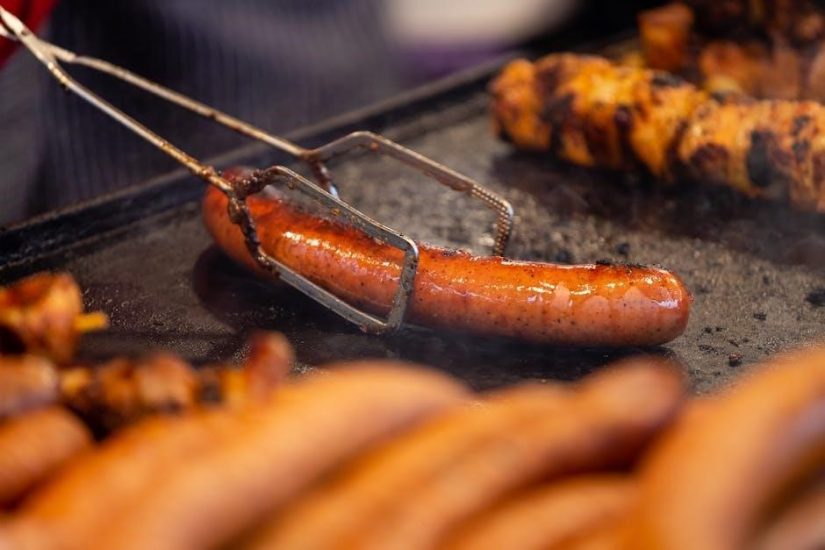Meat smoking is a traditional cooking method that enhances flavor and texture by exposing meat to low-temperature smoke over extended periods, creating tender, aromatic dishes.
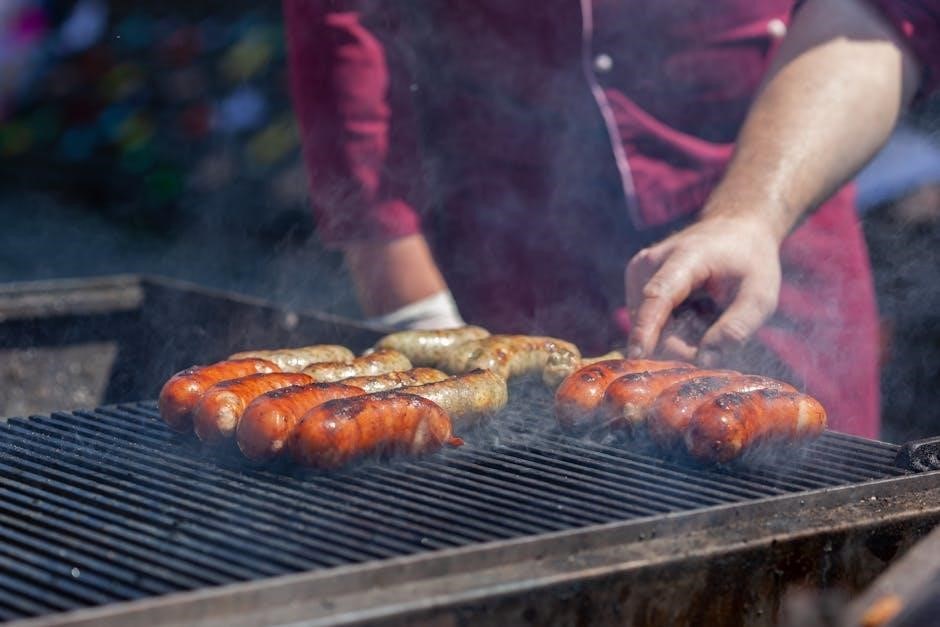
1.1 What is Meat Smoking?
Meat smoking is a low-heat, slow-cooking process that uses smoke to infuse flavor and preserve meat. It involves exposing meat to controlled smoke from burning wood or other materials over an extended period. This traditional technique enhances the natural flavors of the meat while creating a tender, aromatic texture. Smoking can be done using various types of smokers, such as charcoal, gas, or electric, each offering unique advantages. The slow, even heat ensures that the meat remains juicy and develops a rich, smoky profile. This method is popular among barbecue enthusiasts and home cooks, as it transforms ordinary cuts of meat into mouthwatering, memorable dishes with minimal effort.
1.2 Benefits of Smoking Meat
Smoking meat offers numerous benefits, including enhanced flavor, improved texture, and aromatic preservation. The slow, low-heat process breaks down connective tissues, making even tougher cuts tender and juicy. Smoke infuses a rich, savory flavor that cannot be replicated by other cooking methods. Additionally, smoking preserves meat by dehydrating it and creating a protective layer, extending its shelf life. It also allows for versatility, as various types of wood can be used to create unique flavor profiles. Whether you’re a seasoned chef or a novice, smoking meat is a rewarding process that transforms ordinary cuts into extraordinary dishes with minimal effort and maximum flavor impact.
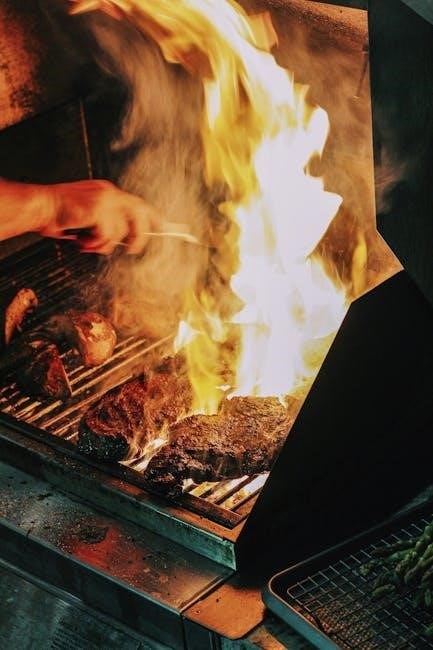
Choosing the Right Smoker
Selecting the ideal smoker involves considering size, fuel type, and durability. Charcoal, gas, and electric models offer unique benefits, ensuring a perfect fit for your smoking needs.
2.1 Types of Smokers (Charcoal, Gas, Electric)
When selecting a smoker, it’s essential to consider your preferences and cooking style. Charcoal smokers are popular for their rich, authentic flavor but require more effort to maintain temperature. Gas smokers offer convenience and ease of use, with precise temperature control and faster setup. Electric smokers are ideal for beginners, providing consistent results with minimal monitoring. Each type has its pros and cons, so choosing the right one depends on your lifestyle, space, and desired level of involvement in the smoking process. Understanding these differences will help you pick the smoker that best suits your needs and ensures a satisfying smoking experience.
2.2 Essential Accessories for Smoking
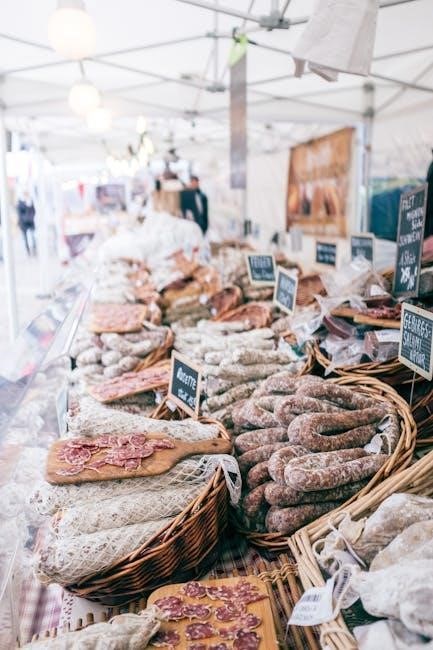
To enhance your smoking experience, several accessories are crucial. A meat thermometer ensures accurate temperature monitoring, while wood chips or chunks add authentic smoke flavor. Water pans help maintain moisture and regulate heat. Heavy-duty gloves protect you from burns, and a spritz bottle allows for adding flavor and moisture during cooking. A grill mat or drip pan catches grease and simplifies cleanup. Accessories like a charcoal chimney, smoker box, and vent controller can also improve efficiency. Investing in these tools will elevate your smoking game, ensuring better control, safety, and flavor. They are must-haves for both beginners and experienced smokers aiming for consistent, high-quality results.
Meat Preparation for Smoking
Proper meat preparation is key to achieving tender, flavorful results. This includes selecting the right cuts, trimming excess fat, and applying marinades or dry rubs for enhanced taste.
3.1 Selecting the Best Cuts of Meat
Selecting the right cuts of meat is crucial for smoking, as it directly impacts the final texture and flavor. Opt for cuts with ample fat and connective tissue, like brisket or pork shoulder, as they become tender and flavorful when smoked low and slow. Lean meats, such as chicken or turkey, also work well but require careful monitoring to prevent drying out. Ribs are another popular choice, offering a rich, unctuous texture when properly smoked. For beginners, consider starting with pork butt or beef brisket, as they are forgiving and consistently yield delicious results. Always choose fresh, high-quality meat for the best outcome.
3.2 Marinating and Seasoning Techniques
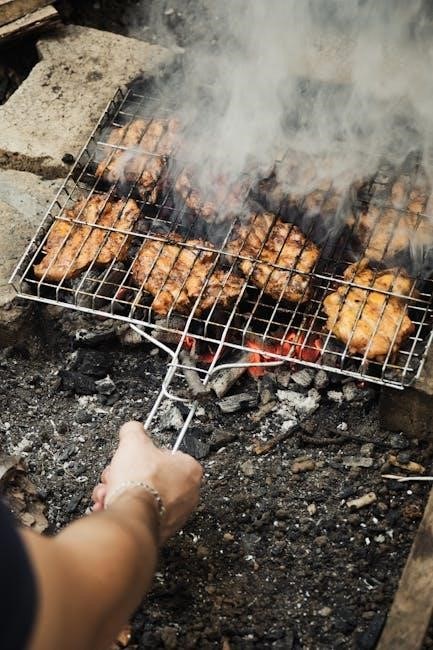
Marinating and seasoning are essential steps in preparing meat for smoking, enhancing both flavor and moisture. Use marinades with acidic ingredients like vinegar or citrus to break down connective tissues, while oil-based marinades help retain moisture. Dry rubs, made from spices, herbs, and sometimes sugar, create a flavorful crust. Apply rubs 24 hours before smoking to allow seasonings to penetrate deeply. For delicate meats like poultry, lighter seasonings with salt, pepper, and herbs are ideal. Always bring meat to room temperature before smoking to ensure even cooking. Experiment with different marinades and rubs to find your perfect flavor profile, ensuring a delicious and aromatic smoking experience.

Smoking Techniques and Tips
Master low-and-slow cooking by controlling temperature, using wood varieties for unique flavors, and maintaining humidity. Monitor meat consistently and experiment with wood types for optimal results.
4.1 Understanding Temperature Control
Temperature control is crucial in meat smoking to ensure tenderness and flavor. Ideal smoking temperatures range between 225°F and 300°F, depending on the meat type. For brisket and pork shoulder, aim for 225-250°F, while fish or poultry may require higher temperatures; Use a meat thermometer to monitor internal temperatures—130°F for rare, 145°F for medium-rare, and 160°F for medium. Adjust vents and fuel to maintain consistency. Proper temperature control prevents overcooking and ensures food safety. Always let the meat rest after smoking to retain juices. Practice makes perfect in mastering this critical aspect of smoking. Consistent temperatures yield consistent results, enhancing the overall quality of your smoked dishes.
4.2 The Smoking Process: Step-by-Step
Start by preheating your smoker to the desired temperature, ensuring it stabilizes before adding meat. Season the meat generously, allowing it to sit at room temperature for 30 minutes to 1 hour before smoking. Load the meat into the smoker, leaving space for even airflow. Monitor temperature consistently, adjusting as needed. Add wood chips or chunks to infuse flavor, depending on the type of wood and meat. Periodically spritz the meat with liquid to maintain moisture and enhance flavor. After reaching the target internal temperature, remove the meat and let it rest for 15-30 minutes before slicing or serving. This process ensures tender, flavorful results every time.
Enhancing Flavor During Smoking
Enhance flavor by using various wood types like hickory, mesquite, or apple, which impart unique smoky notes. Spritzing with liquids like vinegar or butter adds moisture and complexity, while mopping ensures tender, flavorful meat throughout the smoking process.
5.1 Using Different Types of Wood
Different wood types significantly influence the flavor profile of smoked meats. Hickory is popular for its strong, bacon-like aroma, ideal for pork and bacon. Mesquite offers a bold, earthy taste, perfect for beef. Apple wood provides a mild, fruity smoke, enhancing poultry and pork. Maple wood adds a subtle sweetness, while cherry wood combines fruity and smoky notes, ideal for red meats. Experimenting with wood varieties allows you to tailor the flavor to your preference, creating unique and complex taste experiences. Properly seasoning the wood ensures a consistent smoke quality, elevating your smoking results to new heights.
5.2 Spritzing and Mopping for Moisture and Flavor
Spritzing and mopping are essential techniques to maintain moisture and enhance flavor during smoking. Spritzing involves lightly misting the meat with a liquid, such as apple cider vinegar, beer, or water, to keep it tender and prevent drying. Mopping uses a mop sauce—a mixture of ingredients like vinegar, spices, and sometimes butter or oil—applied directly to the meat. These methods not only add moisture but also infuse flavors, balancing the smokiness. Timing is key: spritz every 30 minutes to an hour, while mopping is often done during the final stages of smoking. Both techniques ensure a juicy, flavorful finish to your smoked dishes.
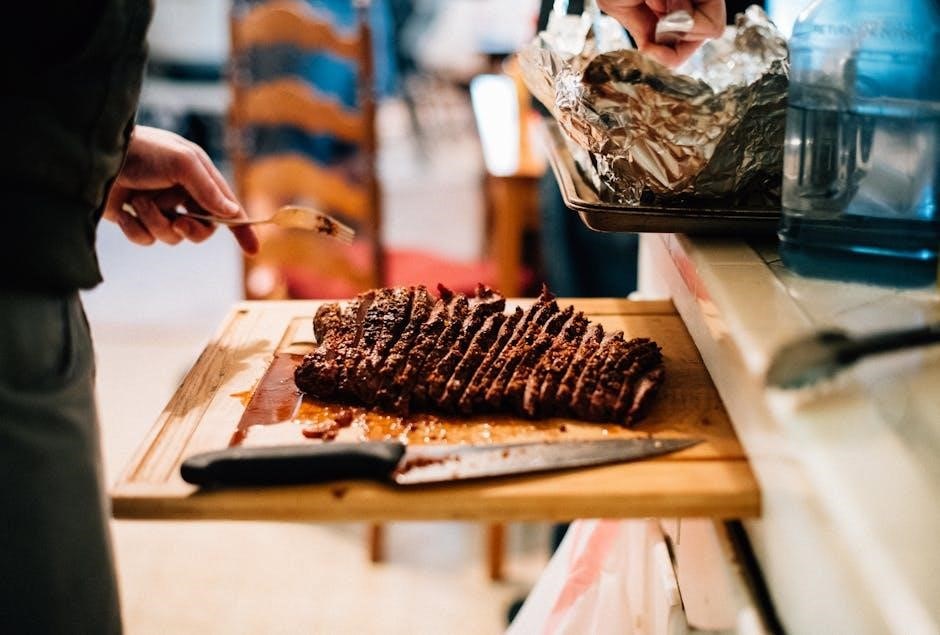
Common Mistakes and Troubleshooting
Overcooking, inconsistent temperatures, and neglecting wood quality are common mistakes. Troubleshoot by monitoring thermometers, using high-quality wood, and ensuring proper ventilation for optimal smoking results.
6.1 Avoiding Overcooking and Undercooking
Avoiding overcooking and undercooking requires precise temperature control and timing. Use a meat thermometer to ensure internal temperatures meet safe levels without drying out the meat. Overcooking leads to toughness, while undercooking can pose health risks. Monitor the smoker’s temperature consistently, especially during the final stages. For meats like brisket or pork shoulder, aim for an internal temperature of 190°F to 205°F for tenderness. Wrap meats in foil if they finish cooking before the desired texture is achieved. Proper resting time after smoking also helps retain moisture and flavor, ensuring a perfectly cooked result every time.
